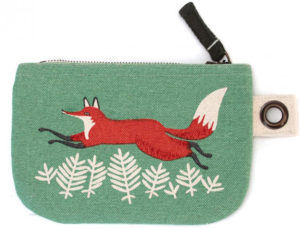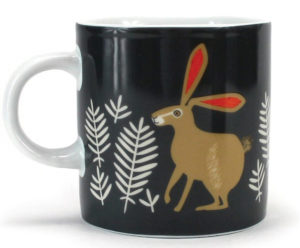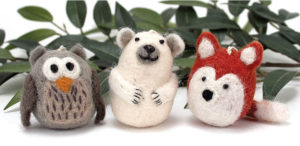 One of the themes of our 2019 catalog is Forest Creatures. This blog post will talk about some forest creatures you will find in Scandinavia — and how one such animal is part of a long-standing feud between Norway and Sweden (and it is NOT the herring).
One of the themes of our 2019 catalog is Forest Creatures. This blog post will talk about some forest creatures you will find in Scandinavia — and how one such animal is part of a long-standing feud between Norway and Sweden (and it is NOT the herring).

Arctic Fox
The Arctic fox (Fjellrev in Norwegian and Fjällräven in Swedish) is one of the most endangered predators in Scandinavia. The Arctic fox lives in the northernmost parts of Norway and is well-adapted to the cold. They build dens or eskers in the arctic tundra and many of these dens will often have multiple entrances and be used by many generations, in fact some have been used for 100’s of years. Arctic foxes do not howl but rather have a high-pitched bark. They eat mainly lemmings and have incredibly sensitive hearing, which they use to locate their prey even under a covering of snow.

The Arctic fox’s coat color changes from winter to summer to help it remain camouflaged and in the winter the grows fur on the bottom of its paws helping it walk on ice and snow as well as keeping its feet warm! Arctic foxes can lower their metabolic rate and body temperature during winter to help conserve their energy. When there is little food available, to increase the Arctic fox’s chances of finding food, they reduce their metabolic rate even further, thus using their energy reserves more slowly.
Read more about the arctic fox here.

White-Tailed Eagle
White-tailed Eagles nest along the entire coast of Norway. They are the largest bird of prey in Europe with a wingspan of up to 94 inches. They mainly eat fish but will also eat carrion, rabbits, and other birds. They are monogamous and remain as a pair for life.
White-tailed Sea Eagles are Sweden’s largest bird of prey, up to 35 inches long with a wingspan of up to 118 inches. They have a square, “barn door” profile in flight and can live up to 25 years. They form a species pair with the American Bald Eagle.
Between 1800 and 1970, populations declined steeply all over Europe. Numbers in Sweden are recovering thanks to intensive conservation measures, including legal protection, habitat and breeding site preservation, winter feeding, and a sharp reduction in the use of harmful chemicals. While still a rare and thrilling sight, White-tailed Sea Eagles are expanding their territories once more, and their recovery in Sweden and in a number of other European countries is a true conservation success story. You can read more about white-tailed eagles in Sweden here.

Wolves
The main wolf populations in Sweden are found in Dalarna and Värmland and in the bordering areas in southeast Norway.
There are thought to be around 350-410 wolves in Norway and Sweden with most of these being found in Sweden. Wolves are considered an endangered species in Sweden and Norway (though not in other parts of the world). In the past wolves were entirely eradicated from Sweden and Norway; the current population is thought to be descended from a small Finnish-Russian population. Wolves in Norway live mainly in forested areas close to the Swedish border, in fact many individuals’ territories cross the border and are often seen in packs of up to 15 wolves. They have a varied diet and will eat anything from a moose to a rabbit and will also feed on carrion.
In Norse mythologies wolves are often portrayed as being evil. One of the most famous mythological stories is about Fenrir who was the wolf son of Loki and who it was foretold would kill Odin, however the other gods manage to bind him up before he has chance to kill Odin using a special Dwarf made chain (in some tales in is a ribbon) although this was at the cost of Týr’s right hand which Fenrir bit off in his rage at being unable to get free.
You can learn more about Nordic wolves here.

Polar Bears
The polar bear is the largest species of bear and is also the most carnivorous. Their diet consists mainly of seals although they will eat whale carcasses and other carrion and have been known to rifle through garbage (in human populated areas) when really hungry.
There are thought to 20,000 – 25,000 polar bears around the world; it is thought that at least 500 polar bears on Svalbard and 1,900-3,600 polar bears in the Svalbard area and the Barents Sea. (Svalbard is between Norway and the North Pole deep within the Arctic Circle. The Svalbard archipelago is the northern most part of Norway, though it is around 500 miles off the northern shore of Norway.) They are usually found on the coast around areas of pack ice and ice floes.
Find out more about polar bears here.

Elk/Moose
Is it an elk or a moose? In Sweden and Norway, the answer is “BOTH”! The iconic, majestic forest dweller Alces alces is known as a moose in North America and an elk in Europe. To make matters even more confusing, elk in North America is used for an entirely different animal – a kind of deer.
Elk may be fairly common and widespread in Sweden and Norway, but they may not be easy to see, especially at close range. Elk are shy creatures, and will retreat into the cover of the deep forest at the slightest disturbance, running with a slow-motion gait that resembles a giraffe running. While it is not unusual for a commuter returning from a day’s work in Stockholm to see an elk standing motionless on the edge of a field in the setting sun, similarly a hunter may wait a week in a hide in the woods and not see a single elk!
The antlers of a male elk can span more than 60 inches and an adult elk can be up to seven-and-a-half feet tall at the shoulder and weigh between 800 and 1600 pounds.
Find out more about moose/elk here. They, apparently, don’t like to share their tee times.

Reindeer
There are no wild reindeer in Sweden. Reindeer found today in the Swedish mountains belong to Sami who tend them. There are thought to be around 30,000 reindeer in Norway and around 10,000 on Svalbard. (Remember Svalbard from polar bears above?) Reindeer feed on lichens, grasses, ferns and shoots of deciduous shrubs (and sometimes Santa will share his cookies with them). They are social animal sand live in large herds. Reindeer in winter grow thicker fur that even covers their antlers. They shed the thick fur in the summer.

Reindeer reign in northern Scandinavia, roaming over the low-growing Arctic tundra, finding food where there seems to be none. Reindeers are charming, relatively small animals, with spreading hooves designed to work like snow shoes, and a rather strange but very fast stride.
Many of the national parks in the heart of Norway, including Rondane National Park and Hardangervidda National Park, are home to wild roaming reindeer. Heading further north in Norway, reindeer can start to look different, thanks to a shorter, whiter variety of reindeer that may have origins in Russia or Canada.
Read more about Scandinavian reindeer here. (Hey that rhymes!)
Musk Oxen (and the great rivalry)

The only Norwegian population of musk oxen live in the Dovrefjell-Sunndalsfjella National Park and surrounding protected areas. The park covers approximately 2700 miles, making this one of the largest continuous protected areas in mainland Norway. The shaggy primeval beast Musk oxen died out in Europe during the last Ice Age. They have now made themselves at home in the park after several re-introductions between 1932 and 1953. Its compact body and robust coat admirably equip this primeval beast to withstand harsh winters in the mountains. Muskoxen live in herds of 12–24 in the winter and 8–20 in the summer.

But, more importantly, for decades, Sweden and Norway have been arguing over musk oxen citizenship.
The Great Scandinavian Musk Ox Rivalry begins about 11,000 years ago. Up until that point, musk oxen ranged throughout the Northern Hemisphere, munching on grass and lichen and standing around looking stately in the snow. But as the Ice Age slowly ended, thaws and hungry humans drove them out of much of their habitat. By the 1900s, the world’s only musk ox herds were in Northern Canada and Greenland.
Read more about this rivalry here.

Eurasian Lynx
The Eurasian lynx is northern Europe’s only big cat.

This medium-sized cat is a beautiful animal that is identified by its bobbed tail, which always has a black tip, as well as by its heavily spotted fur. The Eurasian lynx is found across Europe and in Asia, but are still rare and hard to spot because they are very secretive and quiet in their natural habitats. In Norway, there are just under 500 Eurasian lynx and most are located within the northern part of the country in places like Reisa National Park and Øvre Dividal National Park.
Eurasian lynx are active at dawn and dusk often sleeping out day and night in dense thickets and other safe hiding places; they are good climbers and will use trees and high rocks as places to lay up, watch for prey and even launch ambush hunts from.
Find out more here.

The company En Gry & Sif was created by two talented Danish women in 2000. They design beautiful articles for the home, both decorative and practical, that are then skillfully crafted by Nepalese women from fine New Zealand wool felt in the best Fair Trade tradition. We proudly carry their adorable animal ornaments. These friends are 2 to 2½” and can hang or stand.